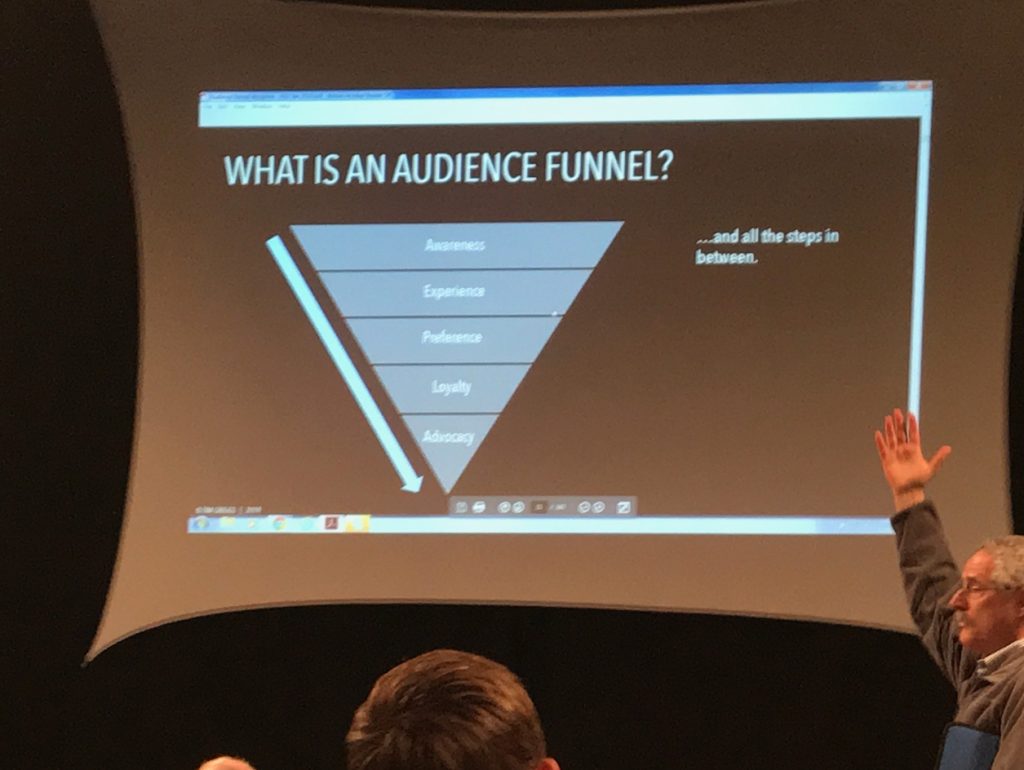Let’s make this simple: How innovative is your newsroom? How effective is your process for innovation? If you are already surpassing your goals on both, congratulations. Stop here.
Most newsrooms I’ve worked in or worked with would admit there’s an aspiration-execution gap between what they’d like to be doing, what they’re actually doing, and how quickly they are transforming. If that’s you, there may be lessons to learn from the first ten local TV stations to complete the Table Stakes Innovation Challenge.
TABLE STAKES FOR TV
Table Stakes for local TV was funded through a grant from the Knight Foundation and adapted from a program created by Doug Smith that’s been previously applied to newspapers and other transforming industries. The term builds on the poker phrase for the minimum to be ‘in the game.’ The year-long program, hosted at the ASU Cronkite School of Journalism, guides participating stations through a challenge-centered approach to innovating around those essentials to be in the game of serving local audiences for news. The first cohort of Table Stakes TV stations completed their year-long challenges in June, and the results were impressive: audience and revenue growth, improved newsroom workflows, and new content created for emerging platforms.
“First round local TV participating stations made excellent progress toward changing how work happened in ways that fostered both better audience and digital experiences as well as better linear TV,” said Doug Smith. “In addition, different stations made substantial progress at defining and serving specific audiences, experimenting and learning about OTT, meeting audiences where they are and when they are there, and taking initial steps toward new sources of revenue.”
WHY MOST INNOVATION FAILS
It’s no mystery why innovation commonly falls short. Newsrooms share common challenges: ‘Lack of resources’ is usually the initial explanation. More deeply, newsrooms mistake activity for outcomes, often switch from one ‘shiny object’ to the next, lack rigor around measuring and tracking results, and therefore lack accountability for change. The ‘Table Stakes’ approach solves for these issues with discipline around the innovation process.
In addition to shifting focus from activities to outcomes, Table Stakes newsrooms are coached to create SMART (Specific, Measurable, Achievable, Relevant, Time-Based) goals. Accountability is built into the program at multiple levels. Stations choose their own innovation challenges, leading to better buy-in. The stations must report progress against their goals every two months during the one-year program, insuring accountability. Along the way, Table Stakes coaches work with the newsrooms to catch instances when they slip back into the habit of tracking activities, like training the newsroom on headline-testing, instead of outcomes like story click-through rates and story session times.
The first cohort of TV news stations in Table Stakes organically focused their efforts on four key areas:
- Newsroom workflow
- Audience targeting to better serve specific audiences
- Emerging platform strategies and content
- New revenue sources
NEWSROOM WORKFLOW: Getting work done smarter
How can workflow be changed to enhance digital-broadcast integration and also improve efficiency? That was the challenge taken on by ABC10 in San Diego. Their final output is a shared spreadsheet built on Smartsheet collaboration software that is customized based on input from all the key newsroom stakeholders. Their home-made system enables work teams to track stories from beginning to end and across platforms, all in one shared document. The project was a big enough success that the tracking system is being scaled to other Scripps stations and who knows – there’s even a chance that this solution could be productized and offered to other newsrooms, in the same way that the Washington Post has re-marketed its ‘ARC’ CMS.

AUDIENCE TARGETING: From “the audience” to many “audiences”
One of the key ‘Table Stakes’ insights is the need to move from thinking of “the audience” as one large mass and instead to recognize the opportunity to target and serve many different “audiences.” Several Table Stakes participants applied this strategy with impressive results.
WhatsApp might not be the first platform you’d think of as a way to engage with your audience about the news. But producers at WXTV Univision-41 in New York learned that WhatsApp is exactly where needed to be to connect with the specific Latino audience they were targeting. WhatsApp is heavily used for free messaging between family members who may be separated by thousands of miles or country borders. As my colleague Andrew Heyward noted in his Cronkite News Lab profile, WXTV’s use of WhatsApp became a valuable source of story leads and audience engagement for the station.
In Spokane, KXLY applied the “audiences” concept by developing a target ‘persona’ (named “Chelsea”) for its news programming. Instead of trying to offer something for everyone (and potentially pleasing no one), the station committed to super-serving Chelsea, the busy mom. News Director Melissa Luck was thrilled to see how committing to this persona led to robust newsroom discussions about both story selection and story treatment. “Why would Chelsea care?” and “How would we tell this story for Chelsea?” became part of the newsroom dialogue.
EMERGING PLATFORMS: Meet the audiences where they’re going
Multiple participants in Table Stakes for TV chose to focus on content strategy and development for their emerging OTT platforms. ABC15 in Phoenix saw great results from featuring its investigative series via its OTT platform. The station also learned valuable lessons from what didn’t work: Marketing the station’s OTT channel via broadcast was far less effective than running targeted advertising campaigns on the OTT platform itself.
WBRC in Birmingham used its OTT channel as a place to pilot an extra hour of the morning show “Good Day Alabama.” The pilot worked so well the station wound up moving the show to the primary broadcast channel, extending its local programming by a full hour.
NEW REVENUE: Building a sustainable news model
Sometimes the biggest innovations start in the smallest markets, where there is less corporate ‘oversight’ and where everyone is used to doing everything, so there are fewer barriers between roles. That was certainly true of KPLC in Lake Charles, Louisiana, which set out to find new revenue sources and discovered that the easiest was licensing its archival content to ride the current wave of podcast and programming creation. Now, the station’s corporate team is thinking about ways to scale the revenue wins in Lake Charles and leverage all the stations’ archives better.
In San Antonio, fans of KSAT have embraced the “KSAT Insider” program, the station’s experiment at a membership model for local TV. While local newspapers have rushed to put up paywalls and charge digital subscription fees to visitors, that hasn’t been the case in local TV. One reason is that viewers are used to their local channels being free. But Pew Research has consistently found that local TV stations rank highest in public trust, and many enjoy strong local brands. KSAT has had thousands of sign-ups for its members program, quickly sold out a members-only event offer, and is continuing to explore how this membership program could reward loyalty.
Most participating newsrooms overachieved against the innovation challenge goals they set for themselves, prompting the obvious question: What was different about Table Stakes that helped them achieve these results? First was the fact that stations chose their challenges, guaranteeing they had ‘skin in the game.’ Second, leaders found it very helpful to be coached away from the activities trap (being busy, but not productive) and to instead focus on outcomes. Third, every station chose to let go of some activities to create capacity to take on the new challenges, As I noted in an earlier column, creating a STOP list first is the best way to create time for more productive activities. Finally, what gets measured gets done. Every station was forced to commit to measurable goals, and held to account every two months. By the end of the year, that led to substantial results.
“What worked so well for me about the Table Stakes approach to innovation is how much it encourages constant assessment of what you’re doing,” said Melissa Luck, News Director at KXLY in Spokane. “It’s not ‘change for change’s sake’; instead, we were encouraged to constantly analyze what was working and to ditch the things that weren’t.”
“So many times when organizations are trying to do something new and fresh, the focus is on getting it done,” noted Bernice Kearney, News Director at KSAT San Antonio. “With Table Stakes, we took the journey deeper and spent time figuring out why a change was important (or was it really just change for the sake of change?). Why we wanted to grow and evolve in a certain manner. Why this was in the best interest of our community, our organization, and our audiences. Inevitably we found that getting to the heart of the matter really sharpened our focus on the project we wanted to tackle.”
The year-long effort was itself an experiment, part of the Knight Foundation grant for innovation in local TV news that’s also powering our Knight-Cronkite News Lab and the news experiments being done by students and faculty at ASU’s Cronkite newsroom. What these efforts share in common is a belief in the importance of collaboration, and learning from each other. We’ll keep sharing those lessons here via the Cronkite News Lab. Together, we can build a sustainable local news community.
Get the Lab Report: The most important stories delivered to your inbox
